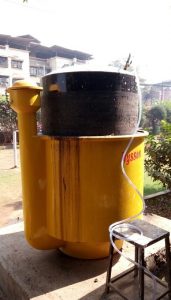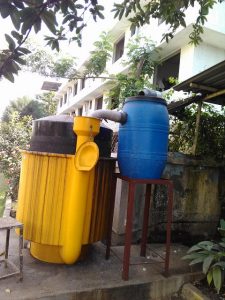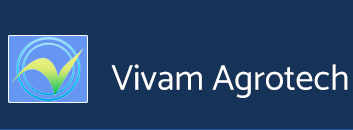Advantages of Biogas:
- Smokeless cooking gas.
- Manure as a byproduct.
- Decentralization of energy generation.
- Environmental balance / Pollution control.
New Compact Biogas Model:
The impending scarcity of petroleum threatens the world’s fuel supply. Mankind can face this threat successfully with the help of biogenous methane, but the world is prevented from taking full advantage of this technology, because its practitioners ignore the basic tenet of science, namely that output of work is dependent on the energy available for doing that work. The current practice of using low calorie inputs like cattle dung, distillery effluent, municipal solid waste or sewerage, makes methane generation highly inefficient. By using feedstock having high calorific and nutritive value to microbes, the efficiency of methane generation can be increased by several orders of magnitude.
General Specifications:
- Biogas Plants are the first portable plants anywhere in the world;
- Molded in one tough piece by state of the art Rotational Molding process manufactured from
- Grade of Polyethylene material confirming to the requirement of IS 10146 – 1982;
- Non toxic;
- Free from any contamination;
- Chemical resistant;
- Blended with stabilizers;
- Anti Corrosive and Anti Acidic;
- Absolutely smooth and sanitary;
- Chemical resistant;
- Blended with stabilizers and free from joints;
- Designed specially for Semi Urban and Rural areas to produce Gas from Wet waste.
Basic Qualities:
- Molded in one touch piece.
- Leak proof and strong.
- Light weight and easy to carry anywhere.
- Special bottom design for use on ground or underground.
- Easy to shift as per needs.
- Tested and tried for use under toughest of the conditions.
- Easy to repair in case of accidental damage.
- Designated to last for decades.
- Made in UV stabilized black color for higher absorption of heat.

Just 2 Kg of such feedstock produces about 500g of methane, and the reaction is completed within 24 hours. The conventional biogas system, using cattle dung, distillery effluent, municipal solid waste, sewerage etc. use about 40 Kg feedstock to produce the same quality of methane, and they require about 40 days to complete the reaction.
It is an extremely user-friendly system, because it requires daily only a couple of kg feedstock, and the disposal of daily just 5 liters of effluent slurry.
Methane burns with a blue flame, without producing any smoke or soot. It is therefore an environmental friendly cooking system. In rural India, women generally burn traditional fuel such as agro waste, woody biomass and cattle dung in their cook stoves. These fuels produce pollutants in the form of smoke, soot and carbon monoxide.

Large quantities of oilcake of non-edible oilseeds are already available in India. Their availability is likely to increase in future as the production of bio-diesel from non-edible oils takes off. Banana rhizomes are another category of raw material, which remains unutilized today. Similarly kernels and seeds of citrus, litchi, mango, tamarind etc. are available in large quantities with the respective fruit processing industries. Farmers always have rain damaged or insect damaged grain, spoilt fruits, and rhizomes and tubers etc. that can be used as feedstock in this biogas system.
These plants are available in 4 types:
Waste Handling Capacity ————— Gas Holding Capacity (per day)
10 Kg. Food Waste per day ————- 0.5Cum
20 Kg. Food Waste per day ————- 1.0Cum
30 Kg. Food Waste per day ————- 1.5Cum
40 Kg. Food Waste per day ————- 2.0Cum



